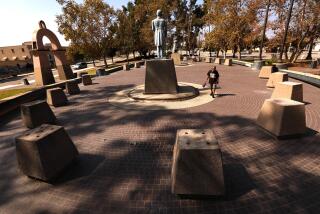LANDMARKS COUNTY HISTORICAL SITES : Oxnard’s Plaza Park Pagoda
- Share via
* HISTORY: The Oxnard Pagoda was built in 1910 to conceal the irrigation system for Oxnard’s Plaza Park. But a year later it was remodeled for double duty as a bandstand. In 1949, the City Council decided against razing the structure. The pagoda, one of the last remaining band pavilions in California, was designated a county historic landmark in 1971.
* LOCATION: At the center of Plaza Park at 5th and C streets in Oxnard.
* HOURS: Visitors may see the pagoda at any time.
Legends flourish about how, why and by whom the pagoda at the center of Oxnard’s Plaza Park was built.
Some say it was brought from Japan. Others insist that Chinese and Japanese residents of the city built it. It was a victory monument, according to another story.
The truth is far more ordinary.
The plaque on the structure says: “The pagoda was built in 1910 to house the pump which supplied water for irrigating the park. It was designed by architect Alfred J. Priest and built by Thomas H. Carroll, Contractor. . . .”
Oxnard’s plaza was laid out in the original plan of the city drawn up by the Colonia Improvment Co. in 1898.
A decade later, the plaza became a city park and, as part of a beautification strategy, the pagoda was planned.
The pagoda, with its octagonal concrete base, Spanish tile roof and eight windows, was finished at a cost of $1,215 for a celebration on July 4, 1910.
The Ventura Free Press reported that 1,500 people came from Ventura alone for the Independence Day celebration.
A parade of 200 decorated automobiles and 22 floats circled the park as part of the route.
However, no one was allowed to get a close view of the pagoda.
The park was fenced off to protect the newly planted lawn and flowers.
The following October, the city Board of Trustees authorized $15 a month toward support of an Oxnard band and in April decided that the pagoda should become a bandstand.
This was accomplished by raising the roof of the existing pump house and building a floor where the roof had been.
The work was completed by Carroll for $745. In August, the city trustees raised the band allowance to $40 a month.
The pagoda was used through the 1920s for civic celebrations, said Madeline Miedema, county Cultural Heritage Board member.
On such occasions, “my father, who was a Presbyterian minister, delivered invocations and benedictions from the platform,” she said.
The pagoda fell into disuse because of limited access to the platform.
Performers or speakers had to climb a narrow staircase, one by one, and crawl through a hole in the floor.
“The Fire Department declared it unsafe,” Miedema said.
In 1949, the City Council contemplated razing the pagoda, but decided against it.
Now the city is considering upgrading the wiring, stairway and platform as part of a renovation of the downtown area, said Michael Henderson, Oxnard parks superintendent.
“Then we could operate events with the feeling that things are safe.”
More to Read
Sign up for Essential California
The most important California stories and recommendations in your inbox every morning.
You may occasionally receive promotional content from the Los Angeles Times.













